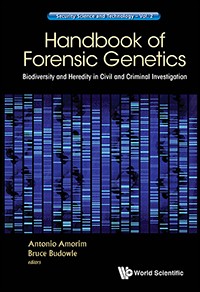System Upgrade on Tue, May 28th, 2024 at 2am (EDT)
Existing users will be able to log into the site and access content. However, E-commerce and registration of new users may not be available for up to 12 hours.For online purchase, please visit us again. Contact us at customercare@wspc.com for any enquiries.
The use of genetics for the resolution of legal conflicts has recently been gaining a higher profile, largely as a result of scientific and technological advancements and the substantial broadening of applications. The theoretical framework underlying forensic genetics is the same irrespective of the materials and technology involved, however a great divide still exists in the manner and processes related to human and non-human analyses.
This advanced handbook intends to overcome the historical barriers between the scientific fields of legal medicine, biodiversity and conservation, and food analysis by presenting a unifying, global perspective on the implications of genetic analyses on forensic affairs. This global perspective is presented in three parts: modes of inheritance and reproduction and taxonomic implications; current technological approaches and future perspectives; and a comprehensive systematization of the types of applications and organisms. Finally, a critical revision of the current investigative/expert systems and future perspectives is undertaken.
This book provides a collection of international research, thereby constituting a reference platform for the forensic community and an advanced textbook for graduate students. It encompasses the theoretical bases of the field, and presents in the context of both perspectives of forensic action — probative and investigative — a comprehensive coverage of the current applications and technological state of the art.
Sample Chapter(s)
Foreword 54 KB)
Chapter 1: Definition and Purpose (95 KB)
Contents:
- Definition and Purpose (Antonio Amorim and Bruce Budowle)
- Mendelian Genetics, Modes of Transmission and Genomics (Antonio Amorim)
- Evolutionary and Population Genetics in Forensic Science (Qasim Ayub, Marc Haber and Chris Tyler-Smith)
- Probability and Likelihood (Amke Caliebe and Michael Krawczak)
- Kinship (Manuel García-Magariños and Thore Egeland)
- Assessing Sampling Error in DNA Evidence (James M Curran)
- Thoughts on Estimating Ancestry (Kenneth K Kidd)
- DNA Mixtures (Torben Tvedebrink)
- Types of Genomes, Sequences and Genetic Markers (Repeats, SNPs, Indels, Haplotypes) (Vânia Pereira and Leonor Gusmão)
- X Chromosome (Nádia Pinto)
- Past, Present and Future of Forensic DNA Databases (C P (Kees) van der Beek)
- The Y-Chromosome Haplotype Reference Database (YHRD) — Publicly Available Reference and Research Datasets for the Forensic Interpretation of Y-Chromosome STR Profiles (Lutz Roewer)
- The Next State-of-the-Art Forensic Genetics Technology: Massively Parallel Sequencing (Bruce Budowle, Jennifer D Churchill and Jonathan L King)
- Massively Parallel Mitochondrial DNA Sequencing in Forensic Genetics: Principles and Opportunities (Jodi A Irwin, Rebecca S Just and Walther Parson)
- DNA and Missing Persons Identification: Practice, Progress and Perspectives (Thomas J Parsons and René L M Huel)
- Molecular Autopsy (Antti Sajantila and Bruce Budowle)
- Predicting Human Appearance from DNA for Forensic Investigations (Susan Walsh and Manfred Kayser)
- Wildlife Forensic Science (Adrian Linacre and Sherryn A Ciavaglia)
- The Application of Forensic Animal DNA Analysis in Criminal and Civil Investigations (Robert Oldt, Jillian Ng and Sree Kanthaswamy)
- Applications of DNA-Based Methods in Food Forensics (Ricardo Araújo, Filipe Pereira and Barbara van Asch)
- Forensic Botany (Kayla Baylor and Heather Miller Coyle)
- Genetic and Genomic Methods of Microbial Taxonomic Assignment (Marc W Allard, Mark Wilson and Eric W Brown)
- Molecular Epidemiology and Evolution Concepts in Microbial Forensics (Fernando González-Candelas)
- Quality Assurance, Recommendations and Standards (Ingo Bastisch)
Readership: Forensic scientists and advanced graduate students in the field.



























